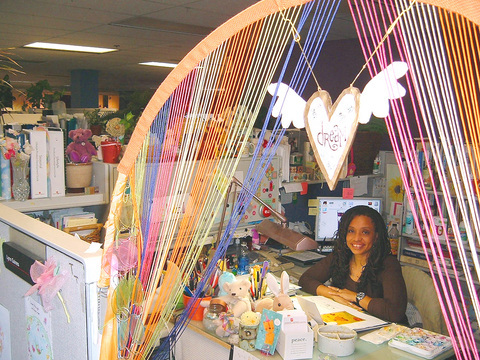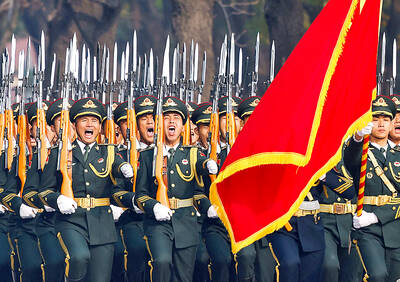Lynn Gaines is the office worker's answer to Martha Stewart.
In her 18 years as a designer and illustrator at American Greetings Corp in Cleveland, her cubicle has undergone several renovations: For a few years it was a garden, complete with an arch of fake ivy, pink silk roses and sparkly little lights. Last month she went retro, festooning the arch with rainbow-color fringe and light-reflecting colored plastic disks.
"It's an extension of who you are," Gaines said of her work space.

PHOTO: NY TIMES NEWS SERVICE
Her company, she said, advocates office personalizing for its 2,200 employees -- who include designers of greeting cards, gift wrapping and party favors -- to encourage creativity and increase productivity.
But American Greetings is apparently in the minority. A national telephone survey of 640 white-collar workers -- conducted by Steelcase, the office furniture maker, and Opinion Research and released in August -- found that only 40 percent of companies encourage employees to personalize their work space. That number fell from 56 percent a decade earlier.
Office workers are taking the hint: Only 59 percent said they personalize their work space, compared with 85 percent who did so in 1996.
Employees said they didn't want to bother co-workers with whom they share office space, didn't have enough space or a permanent space or wanted to avoid seeming unprofessional.
Sometimes, it isn't their choice. The Hearst Corp, the media giant that owns Cosmopolitan, Harper's Bazaar and Country Living, among other magazines, limits personal knickknacks and vacation photos in the shiny new Hearst Tower designed by Norman Foster in New York.
The policy, which was e-mailed to the 2,000 employees who relocated to the tower and has been posted on the company Intranet, specifies limiting "the amount of personal items, stacks of paper and other materials" kept in the blond-wood and gray-metal work spaces and bans carrying in "furniture or lighting without prior approval."
David Masello, the articles editor at Country Living, says his small new cubicle has less room for "things that give me comfort and inspiration."
"It's things like pictures, postcards and paintings," he said. "In my old office, I had a wall of them. Now, I have one-tenth of that."
At Calvin Klein, the company's minimalist aesthetic trumps employee style. In July 2004 executives decreed there could be no desktop displays of photographs, mementos, toys, awards, plants or flowers, other than white ones.
An e-mail directive sent to employees included, as a guide to decorating, a photograph of a black desk with a small number of appropriate, mostly black accouterments.
Malcolm Carfrae, the company's senior vice president for global communications, declined to confirm whether the policy was still in effect.
Written company directives about office decorating are unusual, said William Casey, a management consultant in Golden, Colorado.
"It's difficult to write clear policies on this issue without coming off as a bureaucratic nut," he said.
"The general rule is your self-expression ends at the point that you disrupt work," said Casey, the president of Executive Leadership Group.
"You can hardly write a policy that says, `Don't put up cartoons,'" said Wendi Peck, the chief executive of the company.
They had a client with an employee who plastered his cubicle with Dilbert cartoons.
The collage created such a "negative and depressing" atmosphere, Peck recalled, that the supervisor ordered them removed, though there was no ban.
Even personal photographs can be anathema. After her second child was born, Kelly Welter, who worked for a large accounting firm in Salem, Oregon, had to jettison her older child's baby picture in favor of an image of the children together, because her employer allowed only one personal picture to a desk.
"I was told that the office had to be extremely professional because clients came in," Welter, 34, said.
In a study, Jeffrey Sanchez-Burks, an assistant professor of management and organizations in the business school at the University of Michigan, found that once personal items exceeded 20 percent of a work space, managers began to question a worker's professionalism,
Sanchez-Burks said he had concluded from studies of the US workplace that there is an unwritten rule that workers separate their personal and work lives.
An antiseptic space, though, can sometimes raise employer suspicions.
"In a Denver insurance company, one exec did nothing to personalize his space at all," said Casey, who is also an organizational psychologist.
"It was completely sterile. His boss worried that he wasn't planning on staying," he said.

The Ministry of Foreign Affairs (MOFA) yesterday said it is closely monitoring developments in Venezuela, and would continue to cooperate with democratic allies and work together for regional and global security, stability, and prosperity. The remarks came after the US on Saturday launched a series of airstrikes in Venezuela and kidnapped Venezuelan President Nicolas Maduro, who was later flown to New York along with his wife. The pair face US charges related to drug trafficking and alleged cooperation with gangs designated as terrorist organizations. Maduro has denied the allegations. The ministry said that it is closely monitoring the political and economic situation

UNRELENTING: China attempted cyberattacks on Taiwan’s critical infrastructure 2.63 million times per day last year, up from 1.23 million in 2023, the NSB said China’s cyberarmy has long engaged in cyberattacks against Taiwan’s critical infrastructure, employing diverse and evolving tactics, the National Security Bureau (NSB) said yesterday, adding that cyberattacks on critical energy infrastructure last year increased 10-fold compared with the previous year. The NSB yesterday released a report titled Analysis on China’s Cyber Threats to Taiwan’s Critical Infrastructure in 2025, outlining the number of cyberattacks, major tactics and hacker groups. Taiwan’s national intelligence community identified a large number of cybersecurity incidents last year, the bureau said in a statement. China’s cyberarmy last year launched an average of 2.63 million intrusion attempts per day targeting Taiwan’s critical

‘SLICING METHOD’: In the event of a blockade, the China Coast Guard would intercept Taiwanese ships while its navy would seek to deter foreign intervention China’s military drills around Taiwan this week signaled potential strategies to cut the nation off from energy supplies and foreign military assistance, a US think tank report said. The Chinese People’s Liberation Army (PLA) conducted what it called “Justice Mission 2025” exercises from Monday to Tuesday in five maritime zones and airspace around Taiwan, calling them a warning to “Taiwanese independence” forces. In a report released on Wednesday, the Institute for the Study of War said the exercises effectively simulated blocking shipping routes to major port cities, including Kaohsiung, Keelung and Hualien. Taiwan would be highly vulnerable under such a blockade, because it

Conflict with Taiwan could leave China with “massive economic disruption, catastrophic military losses, significant social unrest, and devastating sanctions,” a US think tank said in a report released on Monday. The German Marshall Fund released a report titled If China Attacks Taiwan: The Consequences for China of “Minor Conflict” and “Major War” Scenarios. The report details the “massive” economic, military, social and international costs to China in the event of a minor conflict or major war with Taiwan, estimating that the Chinese People’s Liberation Army (PLA) could sustain losses of more than half of its active-duty ground forces, including 100,000 troops. Understanding Chinese